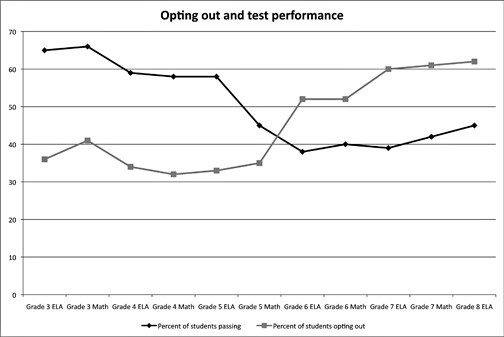Implication of opting out: low scores
A higher percentage of Rockville Centre students failed the New York State exams this year than last year. But many more students also opted out of the tests, which seems to have affected the district’s scores.
In the spring, hundreds of students in Rockville Centre opted out of the state exams. When the data was released last week, it was unclear what affect that had on the scores. But now, after comparing numbers, it seems a correlation exists between low scores and high numbers of students opting out.
“The lowest performance was associated with the highest opt-out,” said Superintendent Dr. William Johnson. “I don’t know what that means. It would suggest to me where you had high opt-out numbers, you didn’t have kids sitting for the exam that took it very seriously.”
In the higher grades, 60 percent or more of students opted out of the tests, which many parents see as frivolous and needlessly difficult. Johnson said that because the state just tells the district how many questions students got wrong, and not which ones, they can’t accurately assess how students are performing and where they need help.
“The validity of the information is hard for us to ascertain since so many people decided not to take the exam,” he said. “The results are not necessarily accurate to what we know about some of the kids.”
Johnson said that, for the most part, the district is going to ignore the state exams as a measure of student performance and focus more on the Northwest Evaluation Association (NWEA) exams. The district administers the exam to all its students and has results returned in just a few days, instead of the months it takes to receive results from the state.
Another reason the district is ignoring the state test results is because the state told them to. “They told us not to use it to make any decisions about kids, and they said not to use it to make any decisions about teachers,” Johnson said. “So the state, not me, said the data isn’t truly valid. I must search for a measure that I believe can replace it, that’s a valid measure of kids ability in reading and math and shows growth over time. And right now, we’ve found what we feel to be a satisfactory alternative [in the NWEA].”
Even though scores decreased on many exams, the district hasn’t heard anything from the state about its performance — leaving it to keep using different methods to evaluate student progress.
“It’s one of the more bizarre situations I’ve been involved in,” Johnson said.
He added that the district is still doing a thorough analysis of the data, and hopes to have something more concrete to share with the community sometime in September.

 44.0°,
Mostly Cloudy
44.0°,
Mostly Cloudy 




